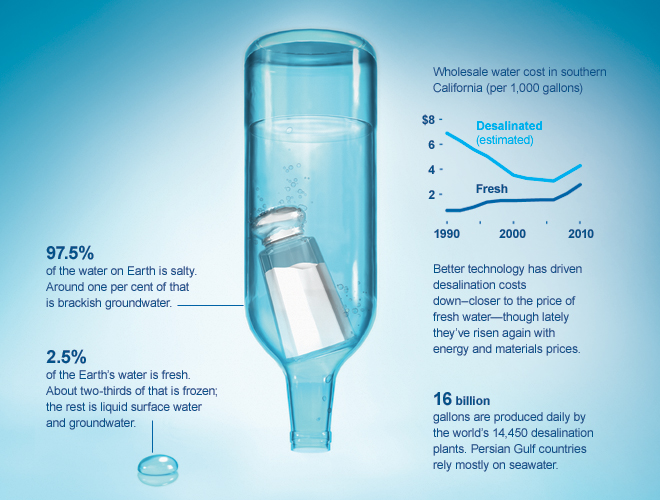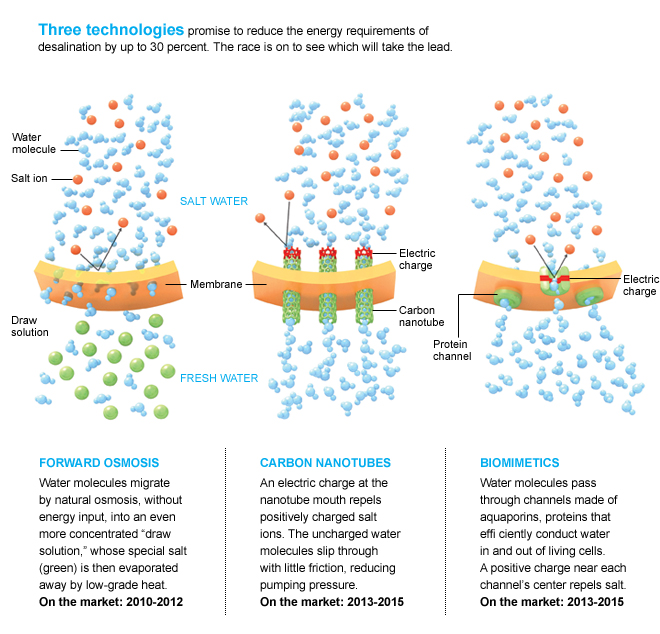Weeks 27 & 28 - Humans Depend on Water Supply and Quality
Read pages 344 - 345
Lesson 4
Its all very well to talk about the need to clean fresh water to ensure its safety, but what if you really don't have access to enough fresh water to start with? For example, there are many desert countries that just don't have enough water to go around. But many of these same countries lie along an ocean or sea. In this lesson we will examine three methods of transforming salt water to fresh water.
|
Did You Know?
A Canadian scientist has developed a system for catching fog on the desert coast of Chile. This fresh water is then used by local villagers. In the past they had to rely on expensive truck loads of water. |
 |
|
The Atacama Desert in Northern Chile is so dry that there are places where rain has NEVER been recorded. Other parts of the desert may go for decades without feeling a single drop of rain. The location is the reason that no rain falls on the Atacama. The Andes block any moisture containing clouds from the east, and the cold waters of the offshore Humboldt current cause any rain on the west side of the Andes to fall at sea. Clouds do form over the area, and a cover of fog, known locally as the camanchaca, often flows inland from offshore. However, the camanchaca and the stratocumulus clouds lack enough moisture to produce rainfall. The small fishing village of Caleta Chungungo has developed an innovative way of harvesting the moisture from the camanchaca. The system consists of large nets arrayed across the slopes perpendicular to the landward flow of the camanchaca. The fog condenses on the mesh and the water drips into a trough. The collected water flows from the trough down through a pipe to a reservoir. |
|
Desalination is the process of removing the salt from seawater to produce fresh water. Read on to learn more about it: (retrieved from National Geographic Magazine, "The Big Idea": March 15, 2010. http://ngm.nationalgeographic.com/big-idea/09/desalination)

Three hundred million people now get their water from the sea or from brackish groundwater that is too salty to drink. That’s double the number a decade ago. Desalination took off in the 1970's in the Middle East and has since spread to 150 countries. Within the next six years new desalination plants may add as much as 13 billion gallons a day to the global water supply, the equivalent of another Colorado River. The reason for the boom is simple: As populations grow and agriculture and industry expand, fresh water—especially clean fresh water—is getting scarcer. “The thing about water is, you gotta have it,” says Tom Pankratz, editor of the Water Desalination Report, a trade publication. “Desalination is not a cheap way to get water, but sometimes it’s the only way there is.”
And it’s much cheaper than it was two decades ago. The first desalination method—and still the most common, especially in oil-rich countries along the Persian Gulf—was brute-force distillation: Heat seawater until it turns to steam, leaving its salt behind, then condense it. The current state of the art, used, for example, at plants that opened recently in Tampa Bay, Florida, and Perth, Australia, is reverse osmosis, in which water is forced through a membrane that catches the salt. Pumping seawater to pressures of more than a thousand pounds per square inch takes less energy than boiling it—but it is still expensive.

Researchers are now working on at least three new technologies that could cut the energy required even further. The closest to commercialization, called forward osmosis, draws water through the porous membrane into a solution that contains even more salt than seawater, but a kind of salt that is easily evaporated. The other two approaches redesign the membrane itself— one by using carbon nanotubes as the pores, the other by using the same proteins that usher water molecules through the membranes of living cells.
None of the three will be a solution for all the world’s water woes. Desalination inevitably leaves behind a concentrated brine, which can harm the environment and even the water supply itself. Brine discharges are especially tricky to dispose of at inland desalination plants, and they’re also raising the salinity in parts of the shallow Persian Gulf. The saltier the water gets, the more expensive it becomes to desalinate.
What’s more, none of the new technologies seem simple and cheap enough to offer much hope to the world’s poor, says geologist Farouk El-Baz of Boston University. He recently attended a desalination-industry conference looking for ways to bring fresh water to the war-torn Sudanese region of Darfur. “I asked the engineers, ‘What if you are in a tiny village of 3,000, and the water is a hundred feet underground and laden with salt, and there is no electricity?’ ” El-Baz says. “Their mouths just dropped.” —Karen E. Lange
In the process of the distillation of seawater the water undergoes a change of state. First, the seawater is heated. This evaporates the water but leaves the salts behind. The water vapor is then cooled and as it condenses, it returns to the liquid state as fresh water! Read about the scientific principles that explain distillation.
|
You may recall that osmosis is the movement of water molecules through a semi-permeable membrane. The water will move from an area of high water concentration through the membrane to an area of lower water concentration. The flow will stop when both sides are equal in concentration. In reverse osmosis, the water molecules will flow against the concentration gradient and move from an area of lower water concentration through the membrane to an area of higher concentration. How is this done? Read this fact sheet about a desalination project in Adelaide, Australia. |
 These and other marine mammals can drink sea water because they can get rid of the excess salt in their bodies. But humans must find ways of turning saltwater to fresh water or perish.
|
Did You Know?  In the past, when sailors set out on a long ocean voyage they had to carry all the fresh water that they would need. Today, modern sailors have portable desalinators so they can make all the fresh water they need. Check out this site if you would like to know more. |
 |
